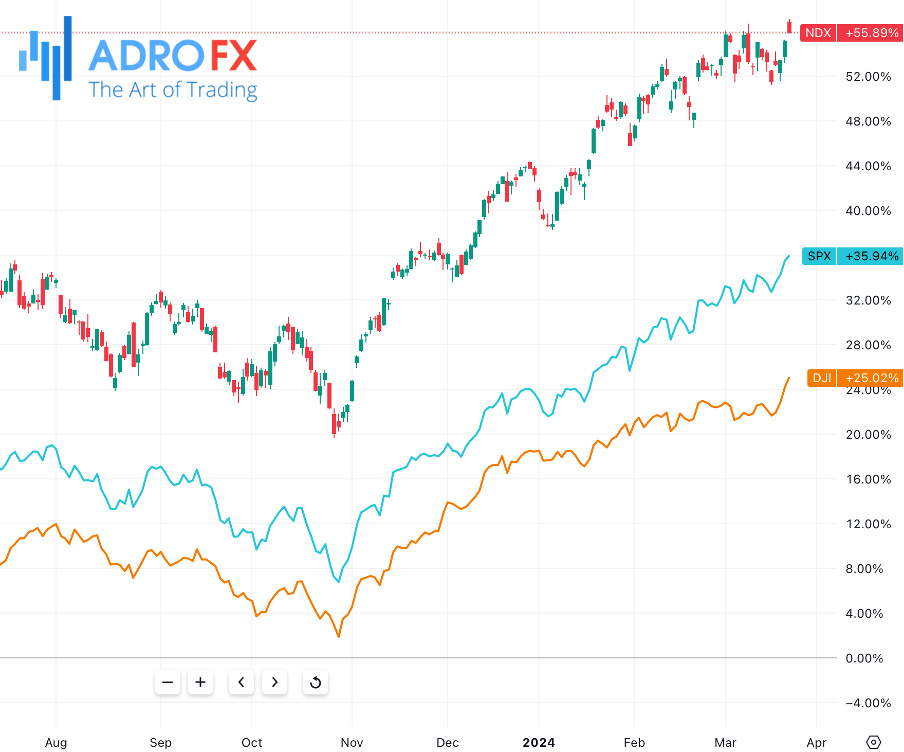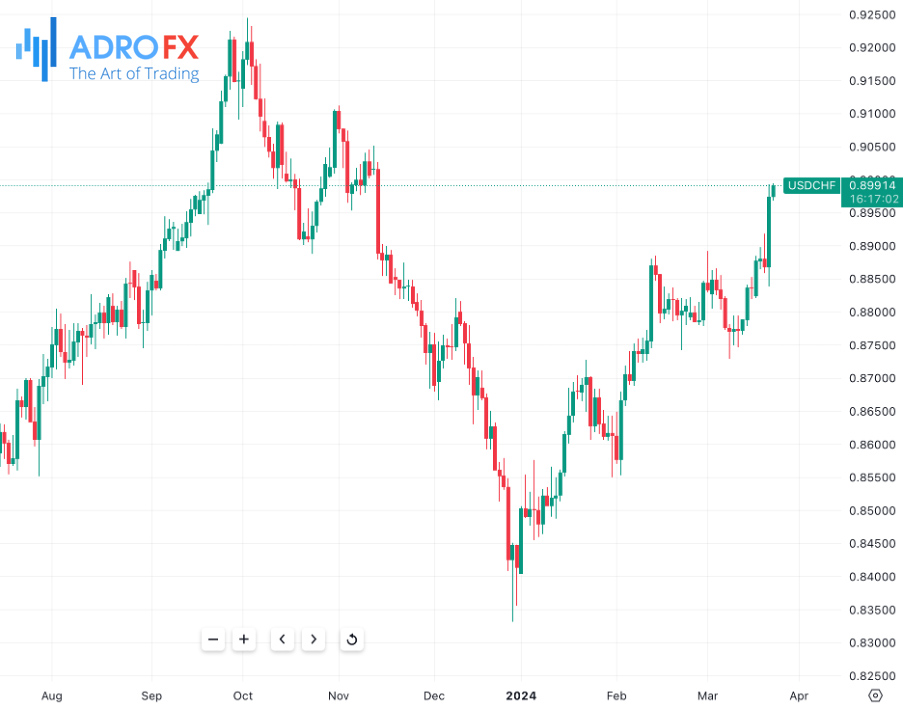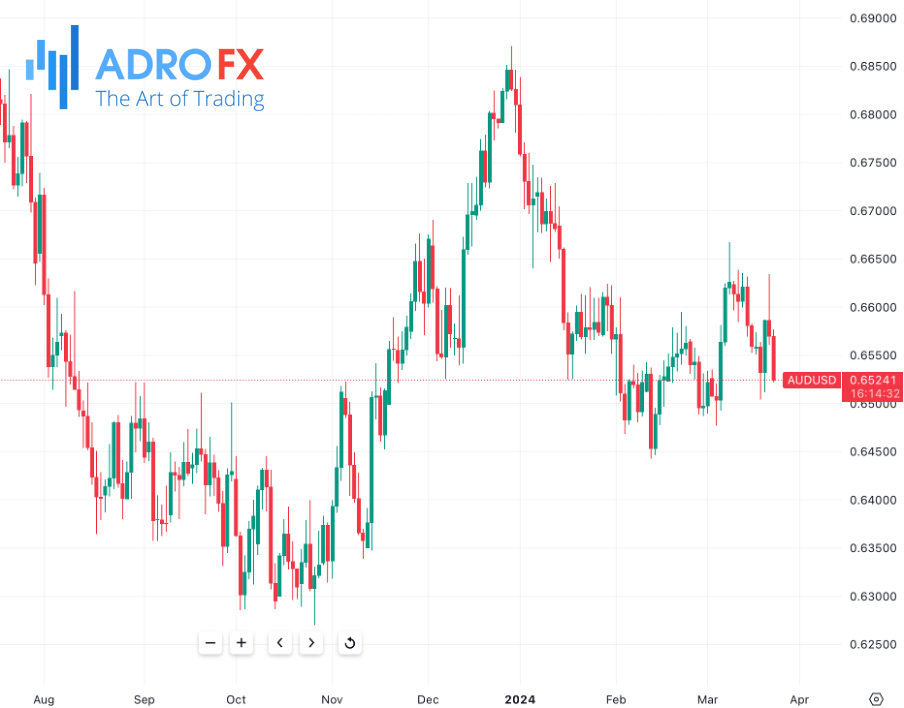US Stocks Surge as Fed Confirms Rate Cut Plans; Eurozone and Swiss Franc React to Economic Developments | Daily Market Analysis

Key events:
- USA - Fed Chair Powell Speaks
- Eurozone - ECB's Lane Speaks
- USA - FOMC Member Bostic Speaks
US stocks continued their ascent on Thursday, extending the record-breaking streak following the Federal Reserve's adherence to its projections of implementing at least three rate reductions this year.
Dow Jones Industrial Average surged by 294 points, or 0.8%, while the S&P 500 advanced by 0.4%, and the NASDAQ Composite edged up by 0.2%.

The anticipation of lower interest rates and the resilience of the US economy have fueled risk appetite, as Fed officials reaffirmed their expectations for three rate cuts in 2024.
Goldman Sachs economists expressed their belief in a note on Wednesday that the Federal Reserve is unlikely to postpone rate cuts for an extended period, aiming for the first reduction during the June meeting. "We anticipate cuts in June, September, and December, totaling 3 cuts in 2024," they emphasized.
Economic indicators continued to demonstrate the robustness of the labor market, with unexpected declines in new claims for unemployment benefits last week, and the Phillip Fed index exceeded expectations, indicating a rebound in manufacturing activity.
Furthermore, the Philadelphia Fed manufacturing index unexpectedly expanded in March.
Apple experienced a decline of over 4% following the filing of a lawsuit on Thursday by the US Department of Justice and 16 states against the tech giant, accusing it of illegally monopolizing the smartphone market.
In response, Apple pledged to "vigorously" defend itself against the lawsuit, asserting its belief that the allegations are "incorrect both in facts and in law."

The EUR/USD pair faced additional losses following the release of US PMI data for March, Initial Jobless Claims, and the Philadelphia Fed Manufacturing Index, all of which bolstered the USD, causing the pair to retreat close to the day’s lows in the 0.6580s.
EUR/USD relinquished some of its gains against the USD after the release of Eurozone HCOB PMI data, revealing a mixed picture of growth in the Eurozone. Although the Composite PMI increased to 49.9, surpassing estimates of 49.7 and the previous February reading of 49.2, an unexpected decline in Manufacturing tempered the outlook.
HCOB Manufacturing PMI in March dropped to 45.7, slipping further into contraction territory (below 50) compared to predictions. Economists had anticipated a more optimistic rise to 47.0 from the previous 46.5.

Meanwhile, Euro area HCOB Services PMI rose to 51.1 in March, exceeding estimates of 50.5 from the previous 50.2, according to S&P Global data. In Germany, the economic powerhouse of Europe, a similar pattern emerged, with HCOB Manufacturing PMI declining to 41.6, below estimates of 43.1 and February's 42.5. However, unexpected improvements were observed in both the Services component and the Composite number.
The Swiss Franc demonstrated weakness of about one percent in its most traded pairs on Thursday, following the decision by the Swiss National Bank to lower interest rates at their March meeting.
The SNB reduced its policy rate by 0.25%, from 1.75% to 1.50% on Thursday, surprising traders who had anticipated a maintenance of the status quo. This decision followed a larger-than-expected decline in Swiss inflation during the early months of the year, alongside a slowdown in economic growth in 2023.

The announcement led to a weakening of the Swiss Franc, as lower interest rates typically deter foreign capital inflows. The move caught markets somewhat off guard, as prior to the event, Reuters reported that only about one in three traders had anticipated a rate cut.
Additionally, the bank revised down its forecasts for future inflation and anticipated growth constraints stemming from a still-strong Swiss Franc and diminished demand from abroad.
During Friday's Asian session, the Japanese Yen rebounded from its year-to-date low against the US dollar, putting an end to an eight-day losing streak. However, this upward movement lacks strong bullish momentum or sustained buying, primarily due to uncertainty surrounding the future policy actions of the Bank of Japan. Additionally, the prevailing risk-on sentiment in the market limits the potential upside for the JPY, which is considered a safe-haven currency.

For the second day in a row, the Australian Dollar depreciated on Friday, influenced by a strengthening US Dollar following mixed S&P preliminary Purchasing Managers Index (PMI) data and strong weekly Jobless Claims figures from the United States.

Additionally, downward pressure on the Australian Dollar stemmed from the decline in the ASX 200 Index. Despite the record highs set by all three major benchmarks on Wall Street, the Australian equity market faced losses, particularly in energy and consumer stocks.









